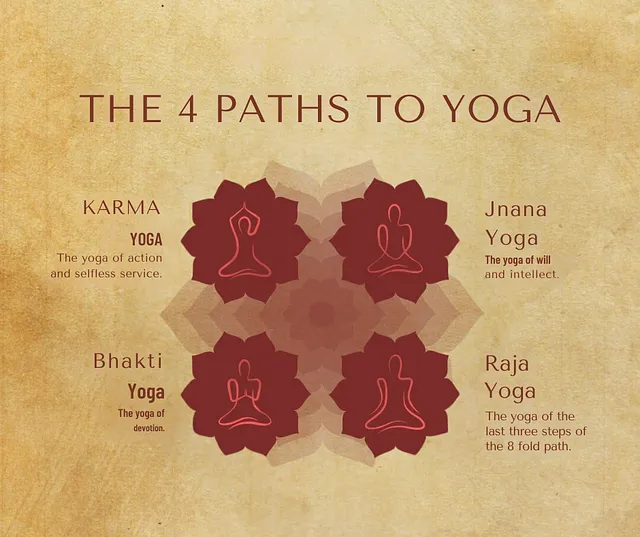
When most people think of yoga, they picture stretching into all sorts of complicated postures. Sure, the physical postures called asanas is a part of this journey. But yoga is about way more than just exercise. It’s an entire way of life and a spiritual journey.
At its heart, yoga comes down to one key goal: union. Yuj or join your individual awareness with the boundless ocean of pure consciousness that yogis call the Divine, Brahman, or Truth.
Sound so easy, right? Well, not quite…
Achieving that state of mind where you are unified with that higher consciousness is the work of a lifetime (or perhaps many).
The good news is that yoga offers several different paths or “margas” to reach enlightenment. Think of them like four different trails all leading up the same mountain peak. You can mix and match, switching between them as you go. Or commit wholeheartedly to a single path. There’s no rule that if you take one approach you shouldn’t go to the other, it’s left to you to take the path of your choice.
Let’s take a look at the four main yoga paths:
Karma Yoga — The Path of Action
The karma yogis strive to act selflessly while fulfilling their duties and serving others, without any desire for personal gain or attachment to the results. By staying grounded in compassionate action for the greater good, they purify the mind and soul.
The same thing has been mention in Bhagvad Gita (2.47)
कर्मण्येवाधिकारस्ते मा फलेषु कदाचन ।
मा कर्मफलहेतुर्भूर्मा ते सङ्गोऽस्त्वकर्मणि ॥ ४७ ॥
karmaṇy evādhikāras te
mā phaleṣu kadācana
mā karma-phala-hetur bhūr
mā te saṅgo’stv akarmaṇi
To understand this in layman’s language “You have a right to perform your prescribed duty, but you are not entitled to the fruits of action. Never consider yourself the cause of the results of your activities, and never be attached to not doing your duty.”
Even Basavanna from the south has emphasized a lot on karma yoga in their work, one of his famous vachans on karma yoga is,
ಕಾಯಕವೇ ಕೈಲಾಸ
‘Kayakave Kailasa’
Which means Work is Worship. He always conveyed that you can reach a divine state just by doing your duties selflessly with the utmost noble intention.
For Karma Yoga my teacher always tells us “Do your best, leave the rest”, just doing your job to the best of your ability without craving recognition. The idea is to transcend the ego through service, good deeds, and doing the right thing.
Bhakti Yoga — The Path of Devotion
Bhakti yoga is the yoga of feeling or deep devotion. If you’re more devotional and heart-centered, bhakti yoga may be your best path. This is all about cultivating profound feelings of love, adoration and attachment to the Divine through ritual worship, prayer, chanting mantras and holy names of the spiritual truth.
The best examples of Bhakti yogis are “Mirabai” & “Akka Mahadevi”.
While Bhakti yogis put a huge emphasis on developing a deep, passionate connection and surrendering to the Divine Source, let not confuse or attach to a specific God, the devotion can be towards a Guru is considered as Bhakti.
Whether using a mantra, a prayer, or a song, this expression allows you to connect deeply to your devotion. A common Bhakti yoga practice is Kirtan which is a series of songs or chants accompanied by music
This path is meant to purify the heart of selfish desires and establish an ecstatic union through devotional rapture.
Jnana Yoga — The Path of Knowledge
Jnana yogis take an intellectual approach, acquiring wisdom and transcendental knowledge to separate the real, infinite truth from illusion and impermanence. This involves intense study of sacred scriptures, self-inquiry through meditation, and discrimination to distinguish one’s eternal self from the attachments and false identification with the body and ego.
The end goal? To directly experience and become fully established in the understanding that you are not the limited, finite sense of “me,” but rather the infinite consciousness itself.
Raja Yoga — The Path of Mind Control
Ever had a hectic “monkey mind” that won’t calm down, no matter how hard you try to meditate?
Raja yoga offers a methodical system to still the turbulent waves of the mind so you can enter the profound depths of pure samadhi (enlightened bliss). This is a path where step-by-step systems and processes have been established by our sages to lead us to the highest level of consciousness.
This is an inward path of meditation that uses practices like physical postures, breath control, concentration exercises, and adherence to ethical principles to gradually restrain the outgoing senses and release the endless thought-waves so you can rest in your true nature of supreme peace and equanimity.
A Holistic Journey
While each of these paths has a different focus and approach, the end goal remains the same — to experience the eternal, blissful freedom of union with the Divine Ground at the core of all existence.
True yogis will pragmatically utilize a combination of all four paths as different stages on the journey, since each one alone may not be complete. Karma yoga purifies the mind, bhakti cleanses the heart, jnana illuminates the intellect, while raja harmonizes the whole system.
No matter which path you’re on, the road to enlightenment is a lifelong adventure undertaking. Stick with a consistent practice and, step-by-step, you’ll eventually reach the mountaintop of self-realization and eternal freedom.